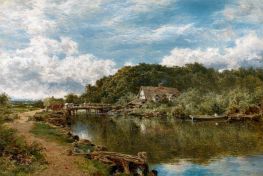
Benjamin Williams Leader Giclée Fine Art Prints
1831-1923
English Realist Painter
He was a painter who always insisted he wanted to capture the tranquil honesty of English scenes rather than chase aesthetic extravagances abroad. Yet it’s precisely this single-minded devotion to local riversides and village churchyards that sets Benjamin Williams Leader apart in the larger Victorian canon. The paintings with gentle light rippling across waters and an unassuming church spire beckoning in the distance, epitomizes how Leader quietly refined an expressive language of atmosphere across his long career. Remarkably, he achieved this evolution without abandoning the sense of place that first inspired him as a boy in Worcester.
Born on March 12, 1831, Leader was initially Benjamin Williams. His father, Edward Leader Williams, was a civil engineer who admired John Constable and spent his free time painting by the Severn River. Early anecdotes depict the young Benjamin slipping in his own brushstrokes when his father stepped away from the easel, foreshadowing a future that seemed bound to the art world. Even so, paternal hopes steered him into engineering. Leader dutifully spent several years drawing up canal plans rather than painting water reflections, but that charade ended when his father allowed him a single year to prove himself as an artist.
Having gained his father’s reluctant blessing, Leader enrolled in the Worcester School of Design and then the Royal Academy Schools in London. Early works drew upon Pre-Raphaelite lessons in fidelity to nature. He captured vivid details and bright colors, as exemplified by "Cottage Children Blowing Bubbles"—a piece that sold immediately and encouraged further exhibitions at the Royal Academy and beyond. By 1857, he rebranded himself as Benjamin Leader to stand apart from another family of artists named Williams, and public reception quickly turned in his favor.
Despite new patrons and growing recognition, he remained dissatisfied with simple brightness alone. He wanted the delicate modeling of real daylight—soft morning haze or the amber glow of late afternoon—and felt it was missing from the mannered intensity of his earlier pictures. His quest for a more organic light guided him toward open-air studies and travels throughout Britain, notably Wales and the Midlands. The shift away from the exacting Pre-Raphaelite style also revealed how deeply he admired John Constable’s tradition, as well as the Barbizon painters Daubigny and Corot, whose emphasis on atmosphere appealed to Leader’s evolving sensitivities.
Settling back in Worcestershire after a short period in London, Leader thrived on regional scenes. He married Mary Eastlake in 1876, an alliance initially met with family resistance but one that ultimately proved supportive both personally and professionally. As the 1880s progressed, he honed his defining approach: a naturalistic light and a well-measured palette that his critics praised for evocative renditions of local fields, rivers, and churches. "February Fill Dyke" (1881) stood out as a commercial triumph and was reproduced extensively as a print.
His crowning honors arrived in the final decades of his life. Made Associate of the Royal Academy in 1883 and later a full Academician in 1898, he also received a gold medal at the Exposition Universelle in Paris and the designation of Chevalier de la Legion d’honneur. By the turn of the century, his reputation had crossed the Atlantic to collectors in America and Canada. Through it all, he never drifted far from those quietly confident views of rural England—compositions that, though never ostentatious, left a lasting mark on British landscape painting. When he died on March 22, 1923, Leader had exhibited over two hundred works at the Royal Academy, a testament to his decades-long devotion to nature’s subtle truths.
Born on March 12, 1831, Leader was initially Benjamin Williams. His father, Edward Leader Williams, was a civil engineer who admired John Constable and spent his free time painting by the Severn River. Early anecdotes depict the young Benjamin slipping in his own brushstrokes when his father stepped away from the easel, foreshadowing a future that seemed bound to the art world. Even so, paternal hopes steered him into engineering. Leader dutifully spent several years drawing up canal plans rather than painting water reflections, but that charade ended when his father allowed him a single year to prove himself as an artist.
Having gained his father’s reluctant blessing, Leader enrolled in the Worcester School of Design and then the Royal Academy Schools in London. Early works drew upon Pre-Raphaelite lessons in fidelity to nature. He captured vivid details and bright colors, as exemplified by "Cottage Children Blowing Bubbles"—a piece that sold immediately and encouraged further exhibitions at the Royal Academy and beyond. By 1857, he rebranded himself as Benjamin Leader to stand apart from another family of artists named Williams, and public reception quickly turned in his favor.
Despite new patrons and growing recognition, he remained dissatisfied with simple brightness alone. He wanted the delicate modeling of real daylight—soft morning haze or the amber glow of late afternoon—and felt it was missing from the mannered intensity of his earlier pictures. His quest for a more organic light guided him toward open-air studies and travels throughout Britain, notably Wales and the Midlands. The shift away from the exacting Pre-Raphaelite style also revealed how deeply he admired John Constable’s tradition, as well as the Barbizon painters Daubigny and Corot, whose emphasis on atmosphere appealed to Leader’s evolving sensitivities.
Settling back in Worcestershire after a short period in London, Leader thrived on regional scenes. He married Mary Eastlake in 1876, an alliance initially met with family resistance but one that ultimately proved supportive both personally and professionally. As the 1880s progressed, he honed his defining approach: a naturalistic light and a well-measured palette that his critics praised for evocative renditions of local fields, rivers, and churches. "February Fill Dyke" (1881) stood out as a commercial triumph and was reproduced extensively as a print.
His crowning honors arrived in the final decades of his life. Made Associate of the Royal Academy in 1883 and later a full Academician in 1898, he also received a gold medal at the Exposition Universelle in Paris and the designation of Chevalier de la Legion d’honneur. By the turn of the century, his reputation had crossed the Atlantic to collectors in America and Canada. Through it all, he never drifted far from those quietly confident views of rural England—compositions that, though never ostentatious, left a lasting mark on British landscape painting. When he died on March 22, 1923, Leader had exhibited over two hundred works at the Royal Academy, a testament to his decades-long devotion to nature’s subtle truths.
4 Benjamin Williams Leader Artworks

Giclée Canvas Print
$56.37
$56.37
SKU: 5520-LBW
Benjamin Williams Leader
Original Size:unknown
Museum and Art Gallery, Birmingham, UK
Benjamin Williams Leader
Original Size:unknown
Museum and Art Gallery, Birmingham, UK

Giclée Canvas Print
$58.41
$58.41
SKU: 5533-LBW
Benjamin Williams Leader
Original Size:46 x 66 cm
Private Collection
Benjamin Williams Leader
Original Size:46 x 66 cm
Private Collection

Giclée Canvas Print
$63.70
$63.70
SKU: 5531-LBW
Benjamin Williams Leader
Original Size:143 x 107 cm
Private Collection
Benjamin Williams Leader
Original Size:143 x 107 cm
Private Collection

Giclée Canvas Print
$57.17
$57.17
SKU: 5535-LBW
Benjamin Williams Leader
Original Size:51 x 76 cm
Private Collection
Benjamin Williams Leader
Original Size:51 x 76 cm
Private Collection